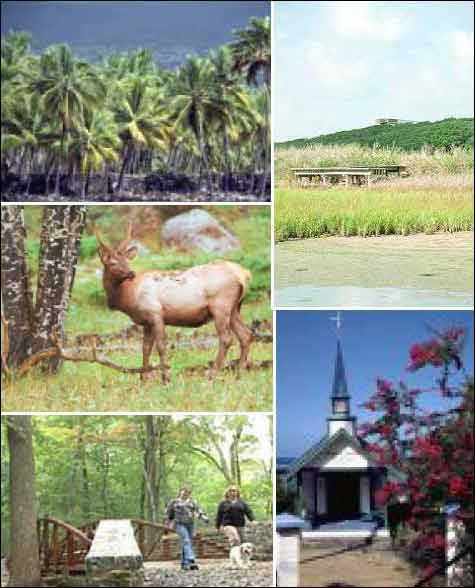















Successes in Stewardship: June 2005 |
|---|

|
Federal Highway Administration
June 2005
Navigating Section 4(f): Updated Policy Paper and New Programmatic Evaluation Now Available

Given the frequent number and diversity of questions regarding application of Section 4(f) of the U.S. Department of Transportation Act of 1966, the Federal Highway Administration (FHWA) recognized the need to clarify and generally improve its Section 4(f) guidance. Although Section 4(f) has been part of Federal law since 1966, its requirements continue to challenge professionals who must navigate the complexities of its applicability criteria and evaluation requirements when developing transportation projects. Accordingly, on March 2, 2005, FHWA released an updated Policy Paper on Section 4(f), the first update since 1989. This updated Policy Paper addresses the needs of FHWA and State DOTs and seeks to guide them through the assessment and review process required under Section 4(f).
The intent of the Section 4(f) statute, and the policy of the USDOT, is to avoid the use of significant public parks, recreation areas, wildlife and waterfowl refuges, and historic sites as part of a project, unless there is no feasible and prudent alternative to the use of such land. When a project proposes to use resources protected by Section 4(f), a Section 4(f) evaluation must be prepared. FHWA issued Policy Papers in 1987, 1989, and now in 2005 to help professionals determine when and how to apply the provisions of Section 4(f).
The 2005 Policy Paper attempts to simplify the guidance and present policy in an easily usable format. The electronic version now includes embedded hyperlinks to allow readers to jump directly to additional guidance on a particular issue, both within the Policy Paper itself and on websites hosted by FHWA and other relevant agencies. It is organized as follows:
The 2005 Policy Paper includes 8 new subject areas with 21 new questions and answers. Apart from its new, user-friendly format and expanded background information, the updated Policy Paper incorporates resource categories that did not exist prior to the Intermodal Surface Transportation Efficiency Act (ISTEA) and the Transportation Equity Act for the 21st Century (TEA-21). The new subject areas include:
|
The Policy Paper Update:
A Collaborative Process Several departments and agencies, including the Department of Housing and Urban Development, Fish and Wildlife Service, and National Park Service, collaborated in updating the Policy Paper, which was spearheaded by various FHWA offices, including the Office of the Chief Counsel and the Office of Planning, Environment, and Realty (HEP). In order to address user needs, over the course of one year input was gathered through interviews and workshops with practitioners, reviews of web-based forums, and official review cycles. Comments Solicited, January to March 2004. FHWA Division Offices, the Office of Chief Counsel, HEP, and the Resource Center Environmental TST were given the opportunity to submit questions and comments and to identify areas that needed clarification and revision. Input Reviewed and Compiled, March 2004. Comments were organized for consideration. To assist in determining subject areas, the Re: NEPA Section 4(f) discussion group was reviewed. Policy Paper Revised, April to October 2004. The Office of Project Development and Environmental Review and the Office of the Chief Counsel revised the paper. Official Review, October 2004. The Policy Paper was distributed to officials, both internal and external to FHWA, for review and comment. Release of Updated Paper, March 2, 2005. The updated Section 4(f) Policy Paper was finalized in February 2005 and then released. The March 2005 Policy Paper supersedes previous versions. Changes focus on addressing new conditions resulting from categories or processes that have been created or modified by legislation and regulations since the previous release in 1989. |
The information provided in the 2005 policy paper is FHWA's official policy on when and how to apply Section 4(f) criteria to various types of land and resources. The Office of Project Development and Environmental Review intends to update this document as new information becomes available or new developments take place. The Policy Paper and subsequent updates will be maintained on the Project Development website and the Environmental Guidebook website. Programmatic Evaluations related to Section 4(f) are also available on the Project Development website.
The Section 4(f) Net Programmatic Evaluation was issued on April 20, 2005 for certain federally assisted transportation improvement projects on existing or new alignments that will use Section 4(f) land, resulting in a net benefit to the Section 4(f) property. "A ‘net benefit’ is achieved when the transportation use, the measures to minimize harm, and the mitigation incorporated into the project results in an overall enhancement of the Section 4(f) property when compared to both the future do-nothing or avoidance alternatives and the present condition of the Section 4(f) property . . . A project does not achieve a ‘net benefit’ if it will result in a substantial diminishment of the function or value that made the property eligible for Section 4(f) protection." The Programmatic is intended to promote environmental stewardship by encouraging actions that enhance Section 4(f) properties. It is also designed to streamline the Section 4(f) process "by reducing the time it takes to prepare, review and circulate a draft and final individual Section 4(f) Evaluation that documents compliance with Section 4(f) requirements."
Contact InformationLamar SmithFHWA Office of Project Development and Environmental Review 400 Seventh Street, SW Room 3222 Washington, DC 20590 Phone: (202) 366-8994 Lamar.Smith@fhwa.dot.gov |
|
|
